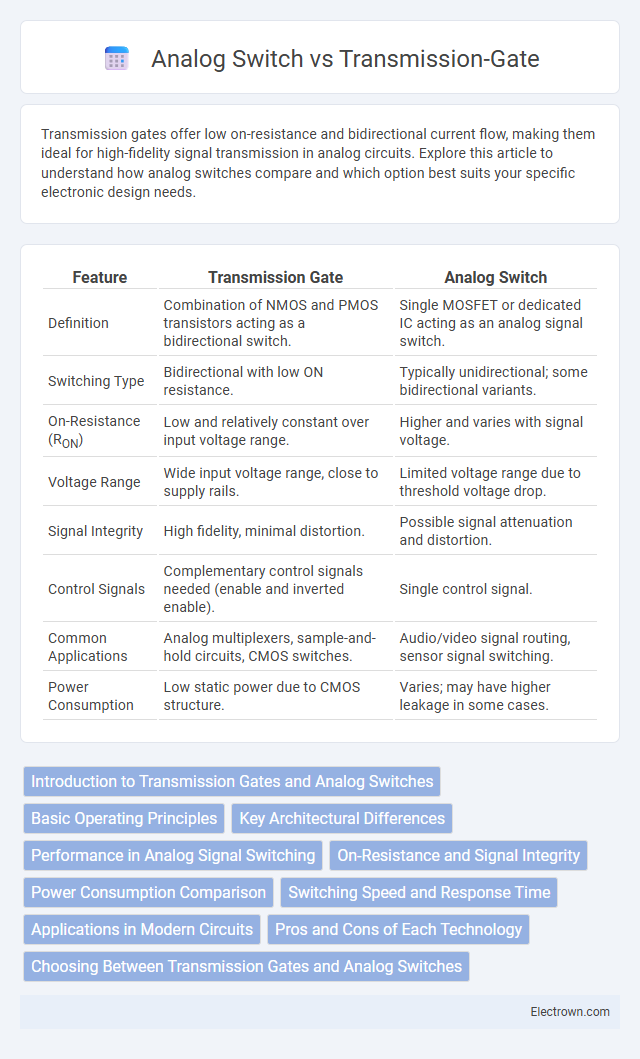Transmission gates offer low on-resistance and bidirectional current flow, making them ideal for high-fidelity signal transmission in analog circuits. Explore this article to understand how analog switches compare and which option best suits your specific electronic design needs.
Table of Comparison
| Feature | Transmission Gate | Analog Switch |
|---|---|---|
| Definition | Combination of NMOS and PMOS transistors acting as a bidirectional switch. | Single MOSFET or dedicated IC acting as an analog signal switch. |
| Switching Type | Bidirectional with low ON resistance. | Typically unidirectional; some bidirectional variants. |
| On-Resistance (RON) | Low and relatively constant over input voltage range. | Higher and varies with signal voltage. |
| Voltage Range | Wide input voltage range, close to supply rails. | Limited voltage range due to threshold voltage drop. |
| Signal Integrity | High fidelity, minimal distortion. | Possible signal attenuation and distortion. |
| Control Signals | Complementary control signals needed (enable and inverted enable). | Single control signal. |
| Common Applications | Analog multiplexers, sample-and-hold circuits, CMOS switches. | Audio/video signal routing, sensor signal switching. |
| Power Consumption | Low static power due to CMOS structure. | Varies; may have higher leakage in some cases. |
Introduction to Transmission Gates and Analog Switches
Transmission gates and analog switches are essential components in analog circuit design, enabling signal routing and switching with minimal distortion. Transmission gates use complementary MOSFET pairs to achieve bidirectional conduction with low on-resistance and high linearity, making them ideal for analog multiplexers and sample-and-hold circuits. Analog switches, typically built from single MOSFETs, offer simpler design and lower cost but may exhibit higher resistance and nonlinearities compared to transmission gates.
Basic Operating Principles
A transmission gate operates using complementary MOSFETs (n-type and p-type) to pass both high and low signals with low resistance and minimal voltage drop, making it ideal for analog signal switching. An analog switch uses a single MOSFET transistor or a combination of devices to open or close a circuit, but it may introduce higher on-resistance and distortion at varying signal levels. The complementary structure of transmission gates provides better linearity and bidirectional switching compared to simple analog switches, optimizing performance in mixed-signal integrated circuits.
Key Architectural Differences
Transmission gates utilize complementary MOSFET pairs to achieve bidirectional signal passing with low resistance and minimal distortion, while analog switches typically employ single MOSFET devices resulting in higher on-resistance and unidirectional signal flow. Transmission gates offer superior linearity and reduced signal degradation, making them ideal for analog multiplexers and sample-and-hold circuits. Your choice depends on the required signal integrity and switching characteristics for your application.
Performance in Analog Signal Switching
Transmission gates offer superior performance in analog signal switching due to their low on-resistance and minimal signal distortion, ensuring high fidelity in analog paths. Analog switches generally exhibit higher resistance and nonlinearities, which can degrade signal quality, especially at higher frequencies. Your choice between the two should consider the required signal integrity and frequency range, with transmission gates being preferable for precision analog applications.
On-Resistance and Signal Integrity
Transmission gates offer lower and more constant on-resistance compared to analog switches, resulting in improved signal integrity and reduced distortion across a wide voltage range. Analog switches typically exhibit higher on-resistance that varies with input voltage, which can degrade signal quality especially at higher frequencies. When maintaining your signal integrity is critical, choosing a transmission gate helps minimize resistance-induced errors and preserve waveform fidelity.
Power Consumption Comparison
Transmission gates typically exhibit lower power consumption than analog switches due to their complementary MOSFET structure, which minimizes leakage currents during operation. Analog switches, often implemented with single-type MOSFETs, can suffer from higher static power dissipation, especially in high-frequency applications. Design considerations such as signal voltage range and switching speed further influence the overall power efficiency of both components in integrated circuits.
Switching Speed and Response Time
Transmission gates offer superior switching speed and faster response times due to their complementary MOSFET structure, enabling low on-resistance and minimal signal distortion. Analog switches, typically built from single MOSFETs or JFETs, exhibit slower switching speeds and higher on-resistance, leading to increased delay and signal degradation. Optimizing for high-frequency applications favors transmission gates for their efficient charge transfer and reduced propagation delay.
Applications in Modern Circuits
Transmission gates excel in analog multiplexers and sample-and-hold circuits due to their low on-resistance and bidirectional conduction, making them ideal for high-precision signal routing. Analog switches are widely used in audio signal processing and data acquisition systems where simple, cost-effective control of analog signals is essential. Your choice between a transmission gate and an analog switch depends on the need for minimal signal distortion and switching speed in modern circuit applications.
Pros and Cons of Each Technology
Transmission gates provide low on-resistance and minimal signal distortion, making them ideal for precision analog switching, but they require complementary control signals and consume more silicon area. Analog switches offer simpler control with single supply voltage operation and compact design, yet they exhibit higher on-resistance and increased signal distortion, limiting high-frequency performance. Selecting between transmission gates and analog switches depends on the trade-off between signal integrity and circuit complexity for the specific application.
Choosing Between Transmission Gates and Analog Switches
Choosing between transmission gates and analog switches depends on signal integrity, power consumption, and control complexity. Transmission gates offer low on-resistance and minimal signal distortion, making them ideal for high-frequency analog applications requiring bidirectional signal flow. Analog switches, typically simpler and more cost-effective, suit low-frequency or digital multiplexing tasks where minor signal attenuation is acceptable.
Transmission-Gate vs Analog Switch Infographic

 electrown.com
electrown.com